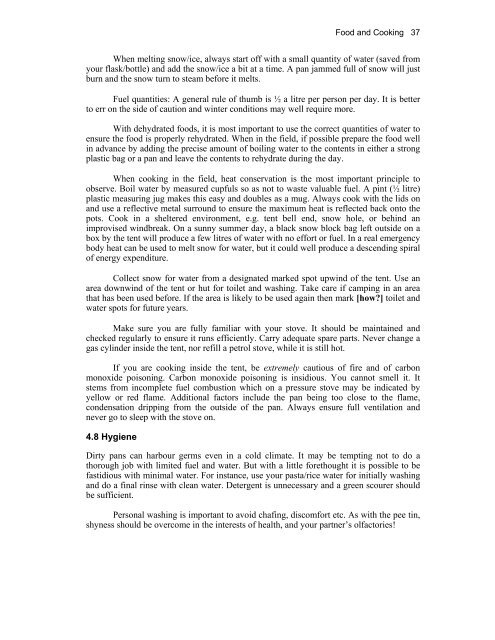Edited by Rachel Duncan 4th Edition ISBN 0-907649-91-2 London ...
Edited by Rachel Duncan 4th Edition ISBN 0-907649-91-2 London ...
Edited by Rachel Duncan 4th Edition ISBN 0-907649-91-2 London ...
You also want an ePaper? Increase the reach of your titles
YUMPU automatically turns print PDFs into web optimized ePapers that Google loves.
Food and Cooking 37<br />
When melting snow/ice, always start off with a small quantity of water (saved from<br />
your flask/bottle) and add the snow/ice a bit at a time. A pan jammed full of snow will just<br />
burn and the snow turn to steam before it melts.<br />
Fuel quantities: A general rule of thumb is ½ a litre per person per day. It is better<br />
to err on the side of caution and winter conditions may well require more.<br />
With dehydrated foods, it is most important to use the correct quantities of water to<br />
ensure the food is properly rehydrated. When in the field, if possible prepare the food well<br />
in advance <strong>by</strong> adding the precise amount of boiling water to the contents in either a strong<br />
plastic bag or a pan and leave the contents to rehydrate during the day.<br />
When cooking in the field, heat conservation is the most important principle to<br />
observe. Boil water <strong>by</strong> measured cupfuls so as not to waste valuable fuel. A pint (½ litre)<br />
plastic measuring jug makes this easy and doubles as a mug. Always cook with the lids on<br />
and use a reflective metal surround to ensure the maximum heat is reflected back onto the<br />
pots. Cook in a sheltered environment, e.g. tent bell end, snow hole, or behind an<br />
improvised windbreak. On a sunny summer day, a black snow block bag left outside on a<br />
box <strong>by</strong> the tent will produce a few litres of water with no effort or fuel. In a real emergency<br />
body heat can be used to melt snow for water, but it could well produce a descending spiral<br />
of energy expenditure.<br />
Collect snow for water from a designated marked spot upwind of the tent. Use an<br />
area downwind of the tent or hut for toilet and washing. Take care if camping in an area<br />
that has been used before. If the area is likely to be used again then mark [how?] toilet and<br />
water spots for future years.<br />
Make sure you are fully familiar with your stove. It should be maintained and<br />
checked regularly to ensure it runs efficiently. Carry adequate spare parts. Never change a<br />
gas cylinder inside the tent, nor refill a petrol stove, while it is still hot.<br />
If you are cooking inside the tent, be extremely cautious of fire and of carbon<br />
monoxide poisoning. Carbon monoxide poisoning is insidious. You cannot smell it. It<br />
stems from incomplete fuel combustion which on a pressure stove may be indicated <strong>by</strong><br />
yellow or red flame. Additional factors include the pan being too close to the flame,<br />
condensation dripping from the outside of the pan. Always ensure full ventilation and<br />
never go to sleep with the stove on.<br />
4.8 Hygiene<br />
Dirty pans can harbour germs even in a cold climate. It may be tempting not to do a<br />
thorough job with limited fuel and water. But with a little forethought it is possible to be<br />
fastidious with minimal water. For instance, use your pasta/rice water for initially washing<br />
and do a final rinse with clean water. Detergent is unnecessary and a green scourer should<br />
be sufficient.<br />
Personal washing is important to avoid chafing, discomfort etc. As with the pee tin,<br />
shyness should be overcome in the interests of health, and your partner’s olfactories!

















